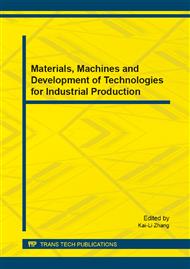[1]
Amyn S. Teja, Pei-Yoong Koh, Synthesis, properties, and applications of magnetic iron oxide nanoparticles, Progress in Crystal Growth and Characterization of Materials 55 (2009) 22-45.
DOI: 10.1016/j.pcrysgrow.2008.08.003
Google Scholar
[2]
JakelyneV. Coelho, Marina S. Guedes, Roberta G. Prado, Jairo Tronto, José D. Ardisson, Márcio C. Pereira, Luiz C.A. Oliveira, Effect of iron precursor on the Fenton-like activity of Fe2O3/mesoporous silica catalysts prepared under mild conditions, Applied Catalysis B: Environmental 144 (2014).
DOI: 10.1016/j.apcatb.2013.08.022
Google Scholar
[3]
Takuya Yoshikawa, Satoshi Shinohara, Taichi Yagi, Naonori Ryumon, Yuta Nakasaka, Teruoki Tago, Takao Masuda, Production of phenols from lignin-derived slurry liquid using iron oxide catalyst, Applied Catalysis B: Environmental 146 (2014) 289–297.
DOI: 10.1016/j.apcatb.2013.03.010
Google Scholar
[4]
Shima Rahim Pouran , Abdul Aziz Abdul Raman, Wan Mohd Ashri Wan Daud, Review on the application of modified iron oxides as heterogeneous catalysts in Fenton reactions, Journal of Cleaner Production (2013) 1-12.
DOI: 10.1016/j.jclepro.2013.09.013
Google Scholar
[5]
T. Hosono, H. Takahashi, A. Fujita, R. Justin Joseyphus, K. Tohji, B. Jeyadevan, Synthesis of magnetite nanoparticles for AC magnetic heating, J. Magn. Magn. Mater. 321 (2009) 3019–3023.
DOI: 10.1016/j.jmmm.2009.04.061
Google Scholar
[6]
J. Park, E. Lee, N.M. Hwang, M. Kang, S.C. Kim, Y. Hwang, J.G. Park, H.J. Noh, J.Y. Kim, J.H. Park, T. Hyeon, One-nanometer-scale size-controlled synthesis of monodisperse magnetic iron oxide nanoparticles, Angew. Chem. Int. Ed. 44(2005).
DOI: 10.1002/anie.200461665
Google Scholar
[7]
W.S. Chiu, S. Radiman, M.H. Abdullah, P.S. Khiew, N.M. Huang, R. Abd-Shukor, One pot synthesis of monodisperse Fe3O4 nanocrystals by pyrolysis reaction of organo metallic compound, Mater. Chem. Phys. 106 (2007) 231–235.
DOI: 10.1016/j.matchemphys.2007.05.039
Google Scholar
[8]
Wei-Wei Wang, Jia-Liang Yao, hydrothermal synthesis of SnO2/Fe3O4 nanocomposites and their magnetic property, J. Phys. Chem. C 113(2009) , 3070–3075.
Google Scholar
[9]
Liwei Hou, Qinghua Zhang, Franc, ois Jérôme, Daniel Duprez, Hui Zhang, Sébastien Royer, shape-controlled nanostructured magnetite-type materials as highly efficient Fenton catalysts, Applied Catalysis B: Environmental 144 (2014) 739–749.
DOI: 10.1016/j.apcatb.2013.07.072
Google Scholar
[10]
Xiantao Wen, Junxiao Yang, Bin He, Zhongwei Gu, Preparation of monodisperse magnetite nanoparticles under mild conditions, Current Applied Physics 8 (2008) 535–541.
DOI: 10.1016/j.cap.2007.09.003
Google Scholar
[11]
Geetu Sharma, Pethaiyan Jeevanandam, synthesis of self-assembled prismatic iron oxide nanoparticles by a novel thermal decomposition route, RSC Advances 3(2013), 189-200.
DOI: 10.1039/c2ra22004k
Google Scholar


